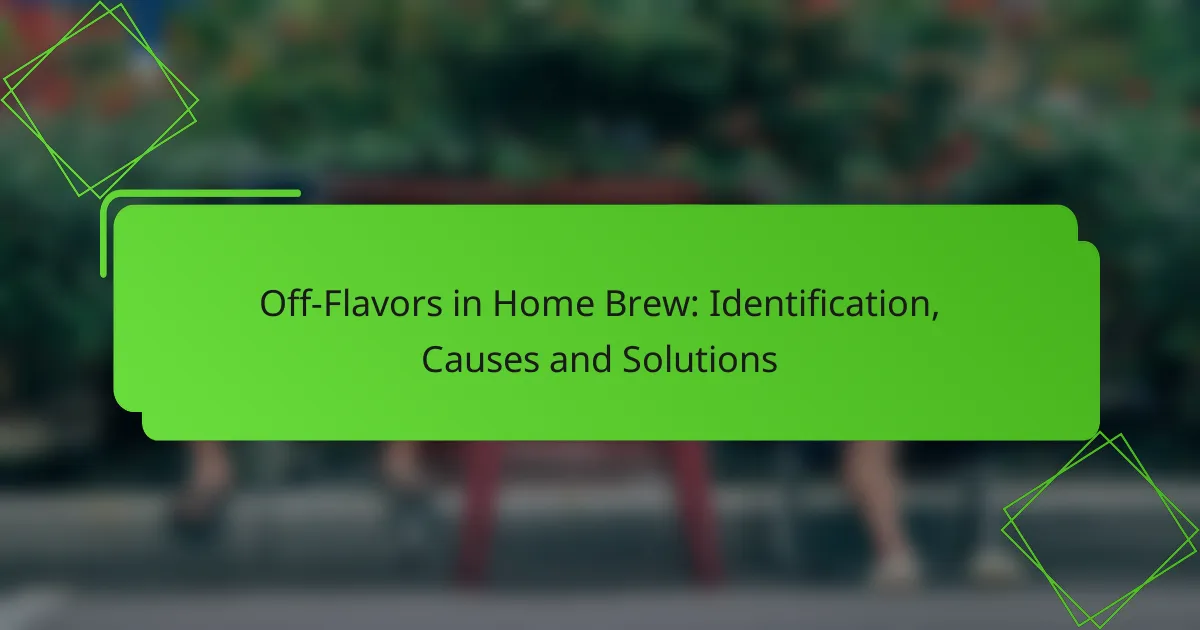Fermentation issues can significantly impact the quality of your brew, manifesting as off odors, unusual colors, or unpleasant tastes. Recognizing the signs early is crucial for preventing spoilage and ensuring a successful fermentation process. Understanding the underlying causes, such as temperature fluctuations or yeast viability, allows brewers to implement effective remedies and enhance their final product.

What are the signs of fermentation issues?
Signs of fermentation issues include off odors, unusual colors, inconsistent bubbles, unpleasant taste, and excessive sediment. Recognizing these indicators early can help prevent spoilage and ensure a successful fermentation process.
Off odors
Off odors during fermentation can signal spoilage or contamination. Common undesirable smells include sulfur, vinegar, or a rotten egg scent, which may indicate the presence of unwanted bacteria or yeast. If you notice these odors, it’s essential to assess the fermentation environment and ingredients used.
To mitigate off odors, ensure proper sanitation of all equipment and ingredients. Using fresh, high-quality ingredients can also help reduce the risk of off-putting smells.
Unusual colors
Unusual colors in your fermenting product can indicate problems. For instance, a greenish or brown hue may suggest oxidation or contamination, while a cloudy appearance could point to yeast or bacterial overgrowth. Monitoring color changes throughout fermentation is crucial for identifying potential issues.
If you observe unexpected colors, consider adjusting your fermentation conditions, such as temperature and light exposure, to promote a healthier fermentation environment.
Inconsistent bubbles
Inconsistent bubbles during fermentation can be a sign of stalled fermentation or insufficient yeast activity. Healthy fermentation typically produces steady bubbling, indicating active gas release from yeast. If bubbles are sporadic or absent, it may indicate a problem with yeast viability or fermentation conditions.
To address this issue, check the temperature and sugar levels, as both can affect yeast performance. If necessary, consider adding more yeast or adjusting the fermentation environment to encourage consistent activity.
Unpleasant taste
An unpleasant taste in your fermented product is a clear sign of fermentation issues. Off-flavors can arise from various factors, including contamination, improper fermentation temperatures, or using low-quality ingredients. Tasting your product at different stages can help identify when the off-flavors develop.
If you encounter unpleasant tastes, evaluate your fermentation process, focusing on sanitation and ingredient quality. Adjusting fermentation time and temperature may also help improve flavor profiles.
Excessive sediment
Excessive sediment at the bottom of your fermentation vessel can indicate incomplete fermentation or unwanted microbial growth. While some sediment is normal, a thick layer can affect the clarity and taste of your final product. Monitoring sediment levels can help you gauge the fermentation’s progress.
To manage sediment, consider racking your product to separate it from the sediment layer. This process can help clarify your beverage and improve its overall quality.

What causes fermentation problems in home brewing?
Fermentation problems in home brewing can arise from various factors that disrupt the fermentation process. Understanding these causes is essential for producing high-quality beer and avoiding off-flavors or stalled fermentation.
Temperature fluctuations
Temperature fluctuations can significantly impact yeast activity during fermentation. Yeast thrives within a specific temperature range, typically between 18°C to 24°C (64°F to 75°F) for ales and 7°C to 13°C (45°F to 55°F) for lagers. Keeping the fermentation environment stable is crucial to prevent stress on the yeast, which can lead to undesirable flavors.
To maintain a consistent temperature, consider using a fermentation chamber or a temperature-controlled environment. Avoid placing your fermenter in direct sunlight or near heat sources, as these can cause rapid temperature changes.
Contaminated equipment
Contaminated equipment is a common cause of fermentation issues, as unwanted microorganisms can spoil the brew. Bacteria and wild yeast can introduce off-flavors and aromas, ruining your beer. Ensuring that all brewing equipment is thoroughly cleaned and sanitized before use is essential.
Use a reliable sanitizer, such as Star San or iodophor, and follow the manufacturer’s instructions for effective cleaning. Regularly inspect your brewing tools for any signs of wear or contamination, and replace them as necessary.
Improper yeast selection
Choosing the wrong yeast strain can lead to fermentation problems, as different strains have unique characteristics and fermentation profiles. Selecting a yeast that is not suited for your specific beer style can result in incomplete fermentation or undesirable flavors.
Research various yeast strains and their optimal fermentation conditions before brewing. For example, if brewing a Belgian ale, opt for a yeast strain known for producing fruity esters and spicy phenols, while a lager yeast should be chosen for a clean, crisp finish.
Insufficient oxygen
Insufficient oxygen can hinder yeast growth and fermentation efficiency. Yeast requires oxygen during the initial stages of fermentation to reproduce and establish a healthy population. Without adequate oxygen, fermentation may stall or produce off-flavors.
To ensure proper oxygenation, gently splash the wort during transfer to the fermenter or use an oxygenation system. Avoid excessive aeration during later fermentation stages, as this can lead to oxidation and spoilage.
Incorrect sugar levels
Incorrect sugar levels can disrupt fermentation, leading to either overly sweet or overly dry beer. Too much sugar can cause high alcohol content and stress the yeast, while too little can result in incomplete fermentation.
Use a hydrometer to measure the specific gravity of your wort before fermentation and adjust sugar levels accordingly. Aim for a balanced wort that provides enough fermentable sugars while avoiding excessive residual sweetness.

How can I fix fermentation issues in beer?
To fix fermentation issues in beer, start by identifying the specific problem, such as temperature fluctuations or yeast viability. Implementing targeted adjustments can help restore a healthy fermentation process and improve the final product.
Adjust fermentation temperature
Fermentation temperature plays a crucial role in yeast activity and beer flavor. Most ales ferment best between 18-22°C (64-72°F), while lagers prefer cooler temperatures around 7-13°C (45-55°F). Keeping the temperature within these ranges can prevent off-flavors and ensure a clean fermentation.
Use a thermometer to monitor the fermentation environment closely. If temperatures are too high, consider using a cooling system or moving the fermenter to a cooler location. Conversely, if temperatures are too low, a heat source like a fermentation heater can help maintain the desired range.
Use fresh yeast
Using fresh yeast is essential for a successful fermentation. Yeast viability decreases over time, so always check the expiration date on your yeast packets. Ideally, use yeast that has been stored properly and is within its recommended shelf life.
If fermentation is sluggish or stuck, consider pitching a new batch of yeast. For dry yeast, rehydrate it according to the manufacturer’s instructions before adding it to the wort. For liquid yeast, ensure it is at room temperature before pitching.
Sanitize all equipment
Sanitation is critical in brewing to prevent contamination that can lead to fermentation problems. Ensure all equipment, including fermenters, airlocks, and bottles, are thoroughly sanitized before use. Common sanitizers include Star San and iodophor, which are effective against a wide range of microbes.
After sanitizing, avoid touching the equipment with bare hands. Use sanitized tools to handle everything, and allow equipment to air dry to minimize the risk of recontamination.
Increase oxygenation
Oxygenation is vital for yeast growth and fermentation, especially during the initial stages. Properly aerating the wort before fermentation can help yeast thrive. You can achieve this by shaking the fermenter or using an oxygenation system with pure oxygen.
Be cautious not to introduce oxygen after fermentation begins, as this can lead to oxidation and spoilage. Aim for a good balance of oxygen during the yeast’s growth phase, typically within the first 24 hours of fermentation.
Monitor sugar content
Monitoring sugar content is essential to ensure fermentation is progressing as expected. Use a hydrometer or refractometer to measure specific gravity before and after fermentation. This will help you determine if the yeast is consuming sugars effectively.
If the gravity readings are stagnant for several days, it may indicate a stuck fermentation. In such cases, consider adjusting temperature, adding fresh yeast, or gently swirling the fermenter to re-suspend the yeast. Regular monitoring can help you catch issues early and take corrective actions.

What are the remedies for wine fermentation problems?
To address wine fermentation problems, several remedies can be implemented to restore healthy fermentation. These include using fermentation additives, adjusting acidity levels, reinoculating with yeast, controlling the fermentation environment, and clarifying with fining agents.
Use fermentation additives
Fermentation additives can enhance yeast performance and improve the overall fermentation process. Common additives include nutrients like diammonium phosphate (DAP) and yeast hulls, which help prevent stuck fermentations by providing essential nutrients.
When using additives, follow the manufacturer’s recommendations for dosages. Typically, adding around 0.1 to 0.5 grams per liter can be effective, but adjustments may be necessary based on the specific wine and fermentation conditions.
Adjust acidity levels
Adjusting acidity levels can significantly impact fermentation. If the must is too acidic, it can inhibit yeast activity; conversely, low acidity may lead to undesirable microbial growth. Aim for a total acidity level between 0.6% and 0.9% for optimal fermentation.
To adjust acidity, you can add tartaric acid to increase acidity or use potassium bicarbonate to lower it. Always test the must before and after adjustments to ensure you achieve the desired balance.
Reinoculate with yeast
Reinoculating with yeast can help restart fermentation if it has stalled. Choose a suitable strain that matches the wine style you are producing, and ensure it is healthy and active before adding it to the must.
When reinoculating, prepare a yeast starter by mixing the yeast with a small amount of must and allowing it to activate before introducing it to the main batch. This method helps to ensure a successful fermentation restart.
Control fermentation environment
Controlling the fermentation environment is crucial for successful fermentation. Maintain a consistent temperature, ideally between 18°C and 24°C, to promote yeast activity and prevent off-flavors.
Monitor the fermentation vessel for oxygen exposure and ensure proper sanitation to avoid contamination. Using airlocks and maintaining a clean workspace can help mitigate these risks.
Clarify with fining agents
Clarifying with fining agents can help improve the clarity and stability of the wine after fermentation. Common fining agents include bentonite, egg whites, and isinglass, each serving different purposes based on the wine type.
When using fining agents, follow recommended guidelines for dosage and application. Typically, adding 1 to 2 grams per liter is effective, but adjustments may be needed based on the specific wine characteristics and desired clarity.



